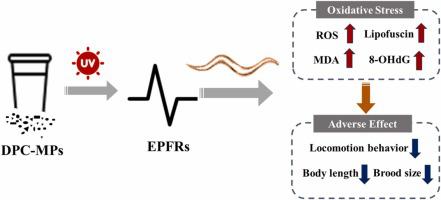Journal of Hazardous Materials ( IF 12.2 ) Pub Date : 2023-11-13 , DOI: 10.1016/j.jhazmat.2023.132990 Hanling Cao 1 , Ping Ding 2 , Xintong Li 2 , Chushan Huang 2 , Xin Li 2 , Xiaoxia Chen 3 , Lijuan Zhang 2 , Jianying Qi 2

|
Microplastics (MPs) are ubiquitous environmental contaminants that exerting multiple toxicological effects. Most studies have focused primarily on the models of unaged MPs and lack environmental relevance. The generation and toxicity of environmentally persistent free radicals (EPFRs) on photoaging MPs from disposable plastic cups (DPC-MPs) have not been well studied. Here, the formation of EPFRs on photoaged DPC-MPs and their toxic effects in nematodes were investigated. UV irradiation generated EPFRs, which influenced the characterization of DPC-MPs. Exposure to photoaged DPC-MPs at environmentally relevant concentrations (100–1000 μg/L) reduced the locomotion behavior, body length, and brood size. The Reactive oxygen species (ROS) production, lipofuscin accumulation, malondialdehyde (MDA), and 8-hydroxy-2′-deoxyguanosine (8-OHdG) levels were increased along with the downregulation of the expression levels of associated genes, such as clk-1, clt-1, and gst-4,in nematodes. Moreover, the toxicity and oxidative stress response of nematodes were significantly inhibited due to N-acetyl-l-cysteine (NAC). Pearson’s correlation analysis revealed that the oxidative stress was significantly associated with adverse physiological effects. Therefore, EPFRs on photoaged DPC-MPs cause toxicity in nematodes, and oxidative stress is important for regulating toxicity. This study offers novel insights into the potential risks of DPC-MPs under UV irradiation, highlighting the need to consider the role of EPFRs in toxicity assessments of DPC-MPs.
中文翻译:

一次性塑料杯中的光老化微塑料上的环境持久性自由基会诱发与氧化应激相关的毒性
微塑料 (MP) 是普遍存在的环境污染物,具有多种毒理学效应。大多数研究主要集中在未老龄议员的模型上,缺乏环境相关性。一次性塑料杯 (DPC-MP) 中的环境持久性自由基 (EPFR) 对光老化 MP (DPC-MP) 的产生和毒性尚未得到充分研究。在此,研究了光老化 DPC-MP 上 EPFR 的形成及其对线虫的毒性作用。紫外线照射产生 EPFR,这影响了 DPC-MP 的表征。暴露于环境相关浓度(100–1000 μg/L)的光老化 DPC-MP 会降低运动行为、体长和雏鸟大小。活性氧(ROS)产生、脂褐质积累、丙二醛(MDA)和8-羟基-2'-脱氧鸟苷(8-OHdG)水平随着相关基因(例如clk)表达水平的下调而增加-1 、 clt-1和 gst-4 ,在线虫中。此外, N-乙酰-L-半胱氨酸(NAC)显着抑制了线虫的毒性和氧化应激反应。皮尔逊相关分析显示,氧化应激与不良生理效应显着相关。因此,光老化 DPC-MP 上的 EPFR 会对线虫产生毒性,而氧化应激对于调节毒性很重要。这项研究为 DPC-MP 在紫外线照射下的潜在风险提供了新的见解,强调需要考虑 EPFR 在 DPC-MP 毒性评估中的作用。











































 京公网安备 11010802027423号
京公网安备 11010802027423号